How do I brush my teeth with an electric toothbrush?
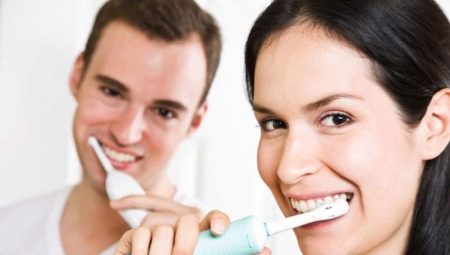
Brushing your teeth is a daily and necessary process of caring for the oral cavity. To make it much more effective will help the use of a modern electric toothbrush that runs on a rechargeable battery or replaceable batteries. Such a device is capable of high-quality cleaning of tooth surfaces even in those places where a regular brush cannot reach, therefore, dental treatment with an electric brush is equivalent to professional dental cleaning.
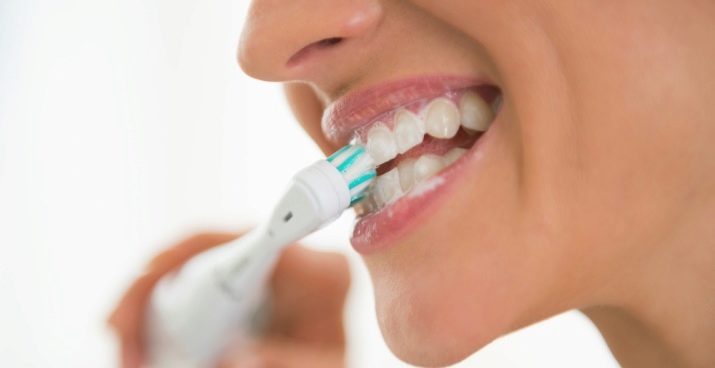
Fundamental rules
Thorough care of the oral cavity, performed on a regular basis, is a prophylaxis aimed at preventing the formation of caries, tartar, and also prevents the development of various gum diseases. Despite all the advantages of an electric toothbrush, dentists often draw the attention of their patients to the fact that, as a result of improper use of a modern hygienic device, certain pathologies of the oral cavity occur. In order to prevent such situations, before you start using the electric brush, you need to learn how to do it correctly.
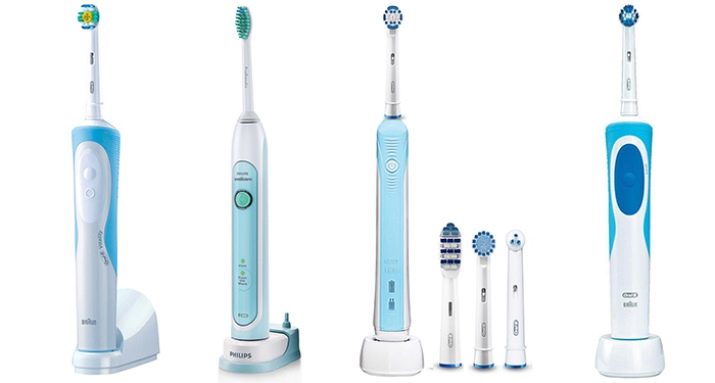
Before you start brushing your teeth with an electric toothbrush, you should carefully study the instructions that come with it. The device can be used often even if you have braces installed, but this should be done carefully and sparingly.

Before use, you will need to charge the device battery or put in replaceable batteries - otherwise the brush will not work.If the batteries are of a weak charge, then the electric brush will noticeably lose its power, which, in turn, will prevent you from using its capabilities as efficiently as possible. Therefore, the battery model of the device must be regularly recharged, and for models with batteries, they must be replaced in a timely manner.
In the case when the brush is completely discharged, it can be used as a conventional mechanical analogue.

Like regular toothbrushes, the electric version is stored in the bathroom, near the sink. In order not to accidentally drop the appliance into the water and not get an electrical injury, it is necessary to find a convenient place for the electric brush, which excludes the possibility of its falling.
The battery-powered device will need to be charged in advance. On average, this process takes 8-12 hours for different models, and the readiness of the electric brush for work can be determined by the color of a special indicator.
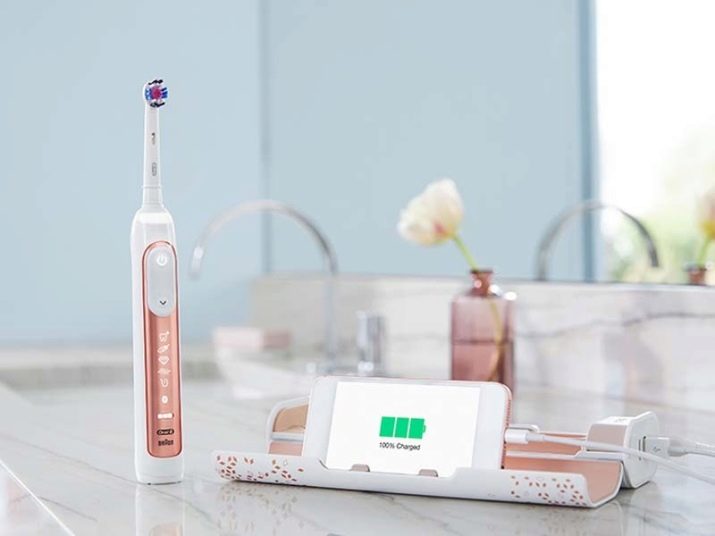
An important point in using a toothbrush is the stiffness of its bristles. The degree of hardness should be selected taking into account the condition of the gums and the sensitivity of the tooth enamel. It is best if your dentist can help you choose the stiffness of the bristles. Most often, soft bristles are used for problems with the gums and for cleaning teeth in children; for other people, medium-hard bristles are suitable. As for the brush with hard fibers, it is rarely used and only on the recommendation of a doctor.

It is better to choose nylon bristles for an electric toothbrush, as it is better subjected to antibacterial cleaning. It is important to note that the tips of the bristles should be rounded to avoid scratching the gum tissue and tooth enamel. Over time, during operation, nylon bristles can wear out, therefore, periodically it is necessary to carefully examine the toothbrush and, if necessary, replace it in time. By fulfilling this condition, you will be able to ensure yourself the highest quality and most effective cleaning of your teeth. When checking the condition of the bristles at the electric brush, pay attention to the following points:
- the presence of jagged or sharp tips on the bristles;
- the presence of areas of loss of bristles from the brush;
- a decrease in the color intensity of colored bristles.

Dentists recommend replacing the head of an electric toothbrush every 3 or 4 months, and if defects are found, such replacement should be carried out immediately.
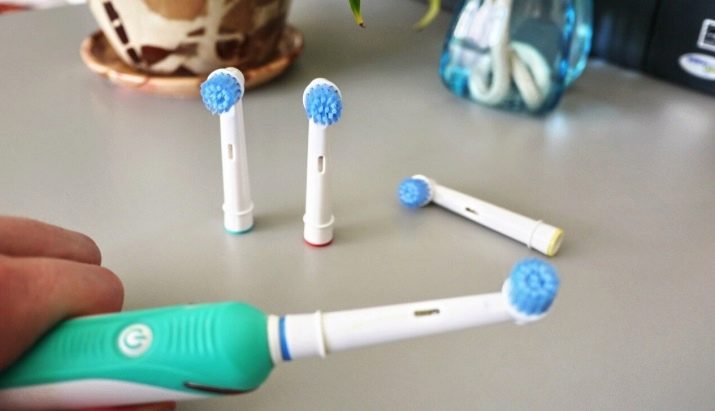
Before starting the process of brushing your teeth, the brush will need to be slightly moistened with water, after which a small amount of toothpaste is applied to its bristles, approximately no more than the volume of a small pea.
To make the process of brushing your teeth more effective, it is advisable to spread the toothpaste over the surface of the teeth. This is best done before the brush is turned on.

Dentists recommend using toothpastes containing fluoride, which helps remove plaque and strengthens the enamel during the cleaning process. If you have sensitive enamel, then for this case, you can choose a fluoride paste designed specifically for sensitive teeth. Such a remedy reduces the increased sensitivity of the enamel and protects it from the development of carious processes.
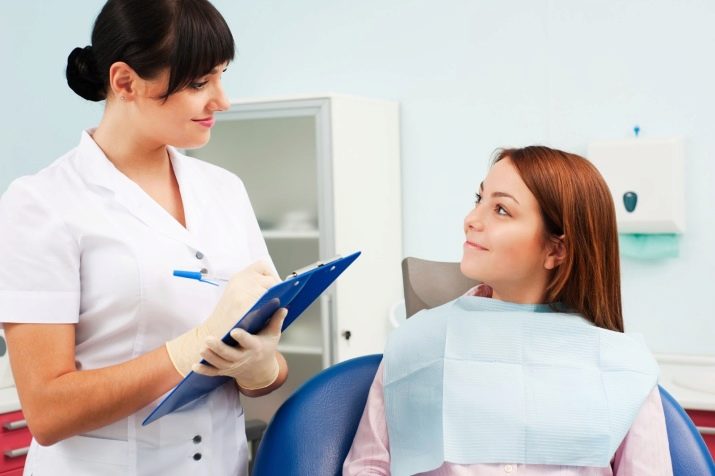
Instructions for use
According to statistics, if you regularly and correctly use an electric brush, then it helps to clean plaque from the teeth 20% more effectively than a simple brush. The use of an electrical appliance makes it easy to care not only for the oral cavity, but also for removable dentures. Human psychology is such that he brushes his teeth much more attentively and accurately if he uses a device in the form of an electrical appliance for this purpose.
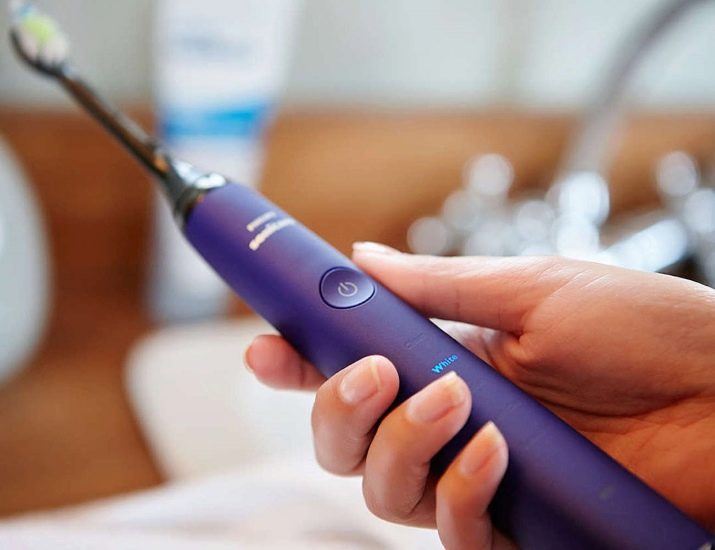
The main requirements that must be observed when using an electric toothbrush are not to press with the cleaning head on the tissue of the gums and teeth, and also not to stay for a long time in one area of the treated surface. Such restrictions are due to the fact that the electrical device, when rotating the nozzle, independently creates the necessary pressure force on the surface to be cleaned, and the rapid rotation of the cleaning head allows you to qualitatively process the desired area of the oral cavity in just a few seconds. Thus, it is enough to bring the electric brush as close to the teeth as possible and not to make additional sharp intensive movements with the cleaning head during the cleaning process, so as not to damage the gums or tooth enamel.
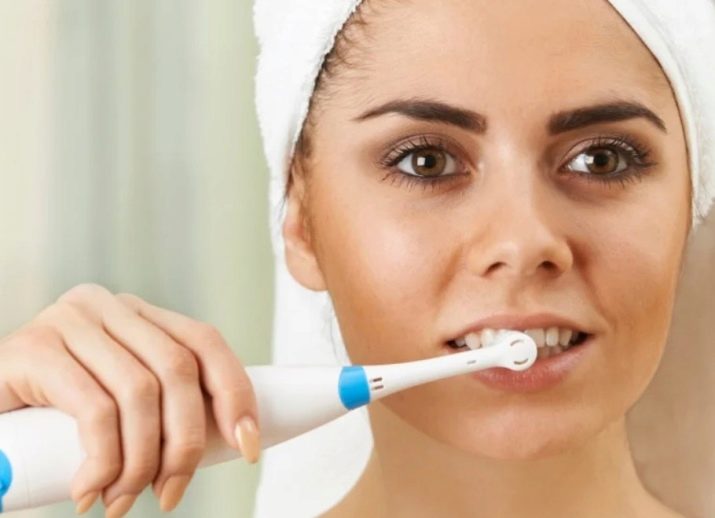
Modern electric toothbrushes are designed in such a way that during operation they rotate or work in vibration mode. In either case, the device allows high-quality processing of the entire dentition, gums, as well as the tongue and the inner lateral surface of the cheek. To use an electric toothbrush correctly, you must follow the procedure for cleaning the oral cavity in a specific order.
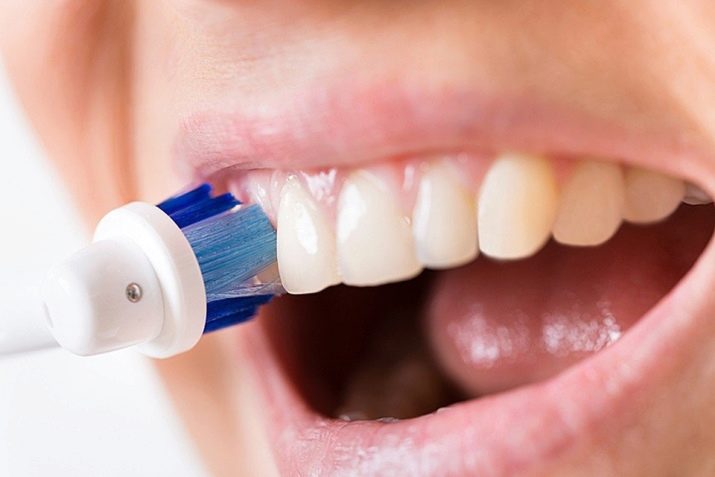
Paste application
Before starting the procedure, the brush should be moistened with water and a small portion of toothpaste should be squeezed onto the surface of the cleaning head. It should be remembered that excess toothpaste will lead to excessive foam formation during the brushing process, which, in turn, can interfere with the quality of the process. The choice of paste also matters when using an electric brush. The best option is a paste that has an abrasiveness of no more than 50 units, which guarantees the safety for the health of tooth enamel. Such a paste not only cleans surface dirt well, but also polishes the surface of the teeth.

Brush position
To cleanse the dentition sequentially, without missing a single site, dentists recommend mentally dividing the oral cavity into 4 zones. Each such zone needs to be processed for 30 seconds, without exceeding or reducing this time. When cleaning, the arm bent at the elbow should be at a 45 ° angle to the gum line, with the cleaning head parallel to the front of the dentition.
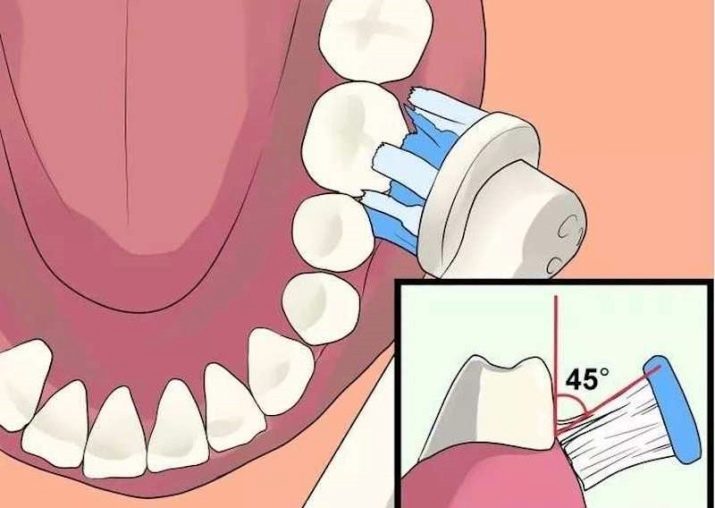
To process your teeth, you will need to pay attention to 3 surfaces.
- Outer side... In this case, the cleaning head is positioned so that it not only covers the dentition itself with bristles at an angle of 45 °, but also touches the gum. Strong pressure is not required, the cleaning head is held in each area for no longer than a couple of seconds. The brush does not need to perform the so-called sweeping movements, since the vibrating head independently cleans out plaque and deposits.
- Inner side. To clean the dentition of the lower jaw, the brush must be held at an angle of 45 °. The processing steps in this case are exactly the same as when brushing the teeth from the outside. But in order to clean the dentition of the upper jaw, the electric brush must be kept in an upright position.
- Chewing surface. To clean teeth that are further than the canines, you will need to clean them from the top position. Cleaning will be most effective if the cleaning head is positioned on the back molars and moved towards the canines.
In general, it should take you at least 2 minutes to complete the cleaning of the entire dentition. It is also not recommended to exceed this time.
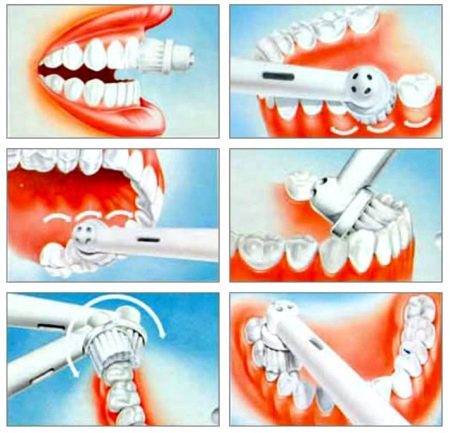
Teeth cleaning
The procedure for cleaning the dentition should be done carefully, since excessive pressing is very harmful to the enamel of the teeth. Any electric brush makes at least 4000 revolutions in 1 minute, and if you neglect the rules of using this device, the tooth enamel is very quickly worn out, and the teeth become very sensitive to any influences.

To make the process of brushing your teeth as comfortable and gentle as possible, it is important not to forget some points.
- Depending on the health of your teeth and gums, you need to choose the right bristle stiffness of the cleaning head and make the right choice of toothpaste.For sensitive teeth, the abrasiveness of the paste should be low.
- Be especially careful when using attachments designed for teeth whitening and polishing. Excessive effort during these procedures can cause injury to the gums or tooth enamel.
- To obtain visible results, the procedure for brushing your teeth must be followed according to the rules and should be done regularly. It is recommended to brush your teeth 2 times a day: in the morning and before bedtime, for 2 minutes.
You should be aware that unreasonably long brushing will not lead to better results, therefore, the use of an electric toothbrush will only be beneficial if the rules of its use are strictly followed.

Completion
After 2 minutes, the treatment of the dentition is completed. This time is quite enough to put your teeth in order. But this is not the end of the procedure for treating the oral cavity, it is necessary to complete its final stages.
- The inner side of the cheek, the upper palate, the surface of the tongue is cleaned, and the gums are also subject to processing. For gentle cleaning of these surfaces, you can use the electric brush in the off mode.
- The next step, dentists recommend cleaning hard-to-reach interdental spaces using dental floss.
- The final stage of the procedure is the use of special solutions with disinfecting properties, which provide long-term protection of the oral cavity from bacteria and freshen breath.
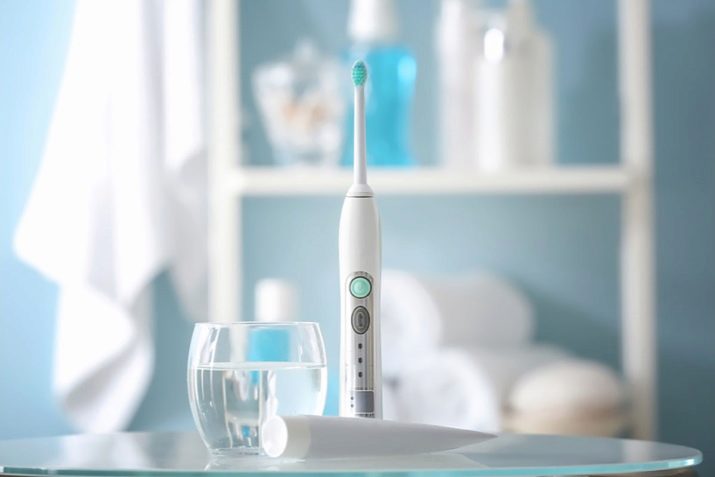
After all the steps of cleaning the oral cavity have been completed, the electric toothbrush must be disconnected from the power source. Next, you have to process it.
- To do this, rinse off the remaining toothpaste from the cleaning head under a stream of warm running water.
- Then the brush must be shaken off the water droplets and dried with a clean cloth.
- The attachment is put on the body of the device and placed to dry in a vertical position. During the drying process, the cleaning head must not be covered with lids or films, as this threatens the development of a bacterial environment on the surface of the bristles.

Scrub head bristles should be treated weekly with any antiseptic, then rinse the brush with water and dry. It is important to replace the brush head at least 2 times a year.
In order for the appliance to serve for a long time, it is important to take good care of its battery, it is recommended not to leave the electric brush permanently connected to the power supply. It is advisable to place the device on the charging base only if the battery is discharged.
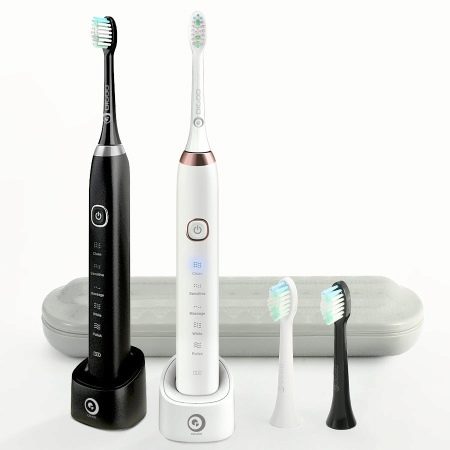
When shouldn't you use a brush?
To maintain dental health, dentists advise their patients to alternate between the use of a simple brush and its electric equivalent. If you use an electric toothbrush on a regular basis, people with bleeding gums or weak tooth enamel may experience unwanted side effects over time.
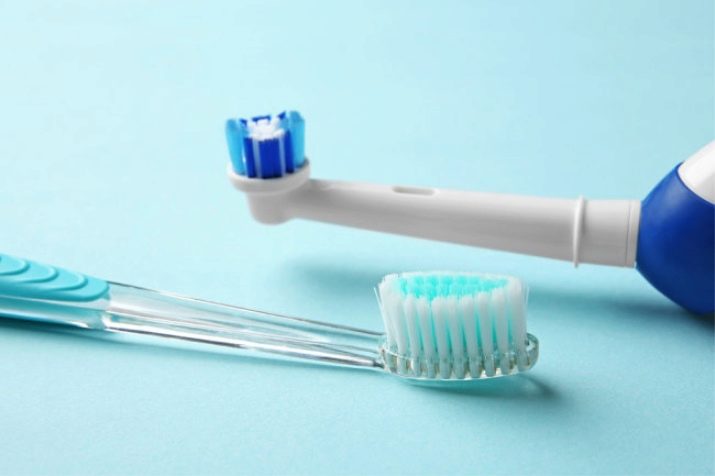
There are some limitations to using an electric toothbrush that should not be neglected.
- It is contraindicated to use the electrocheck in case of periodontal diseases, gingivitis, as well as other inflammatory processes localized in the oral cavity.
- The low density of tooth enamel is an absolute contraindication to the use of this device.
- Areas of caries on the teeth are a temporary contraindication to the use of an electric brush until this pathology is eliminated.
- It is not recommended to use an electric brush for those who suffer from fluorosis, hyperesthesia, wedge-shaped defect. In these cases, the enamel of the teeth is fragile, and mechanical action on it will contribute to its destruction. Only after the enamel remineralization procedure, with the permission of the doctor, can this device be used, but in a gentle mode.
During pregnancy, as well as for people with cardiovascular disease, you can use an electric toothbrush under the supervision of a doctor and with extreme caution.








